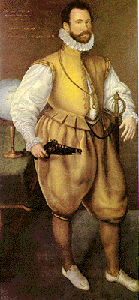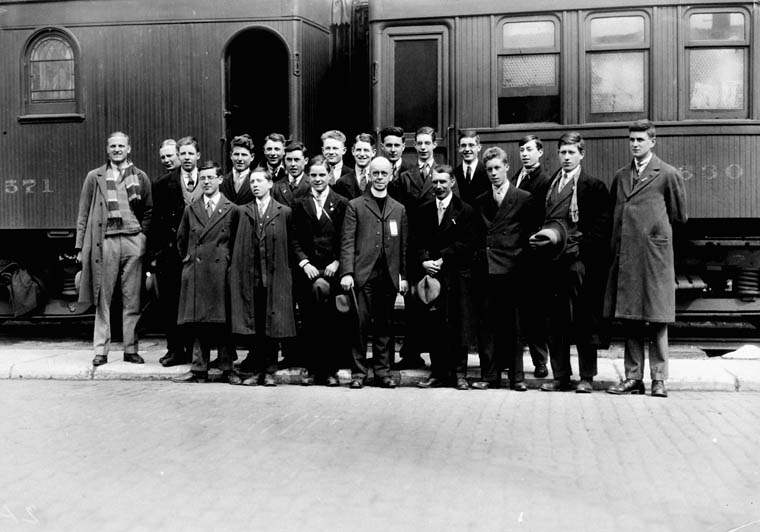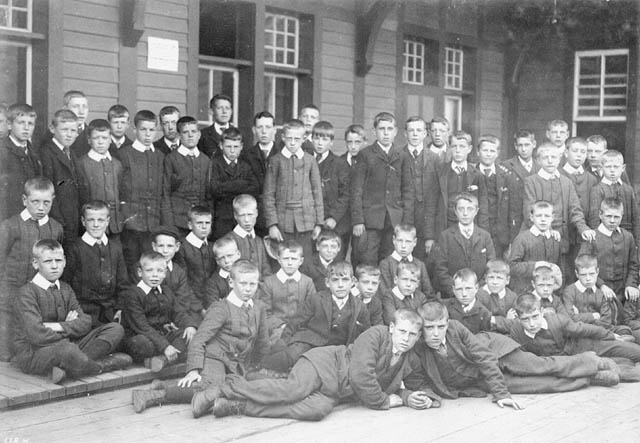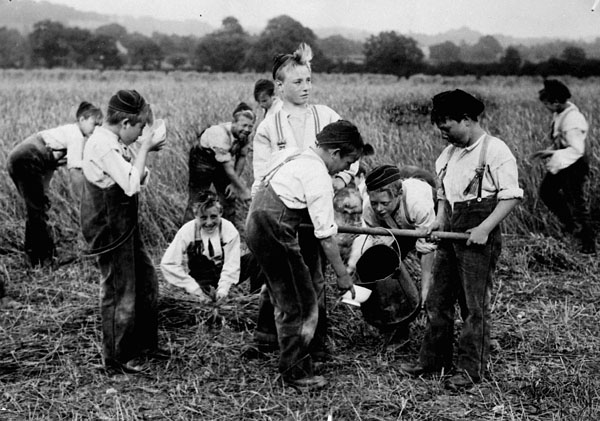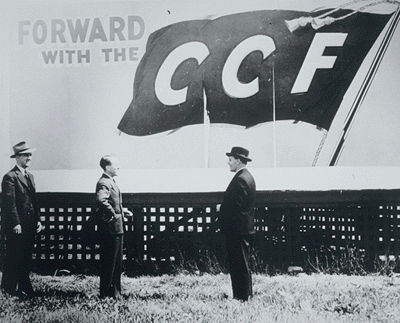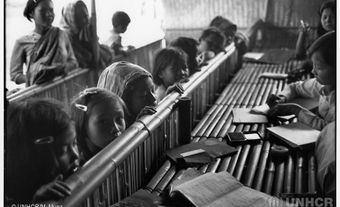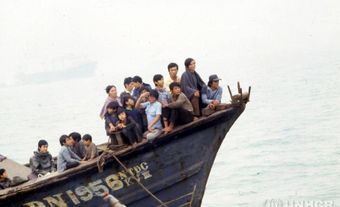The English were among the first Europeans to reach Canadian shores. Alongside the French, they were one of two groups who negotiated Confederation. The expression “English Canadians” refers to both immigrants from England and the Loyalists in exile after the American Revolution and their descendants. According to the 2021 census of Canada, about 14.7 per cent of Canadians (5,322,830 respondents) consider themselves to be of English origin.
Overview
For many years, due to a high rate of immigration from the British Isles, a large portion of Canada's population was English-born. Between 1871 and 1901, about 4 to 5 per cent of Canadian residents had been born in England. In 1911, 7 per cent of the population recorded England as their place of birth, a figure that increased to 8 per cent in 1921. After the Second World War, Canada's English-born population declined. The 1981 census recorded that just under 4 per cent of Canadians were born in the UK, a statistical category that included England. In the 2016 Census, Canadian citizens born in the UK represented 6.6 per cent of Canadians born aboard and less than 1.5 per cent of the Canadian population.
Although Statistics Canada no longer distinguishes “English” from “British” immigrants in its census, the English have generally constituted the largest ethnic group within the larger cohort of British immigrants.
In the 2021 census, over 5.32 million Canadians listed English as an ethnic origin. Around 14.7 per cent of Canadians are of English origin, making them Canada's second largest ethnic group after “Canadian,” the ethnic origin most often reported in the census.
The English and their descendants shaped place names and institutions, as well as the economic, political and cultural life of the country. They have been involved in every aspect of Canada's development. Included among the many well-known Canadians of English origin or English descent are a number of Canada’s prime ministers: Sir John Abbott, Sir Mackenzie Bowell, Sir Robert Borden, Richard Bedford Bennett, Lester B. Pearson, John Turner and Stephen Harper.
English Explorations
15th Century
The English were among the first Europeans to reach Canadian shores after the Norse seafarers of the 10th and 11th centuries. English mariners probably fished in Canadian waters even before John Cabot’s voyage of 1497; John Dee, Queen Elizabeth I's astrologer, who was interested in the discovery of the Northwest Passage through the Arctic and the Asia, found evidence to suggest that two Bristol merchants, Thorne and Eliot, may have reached Newfoundland circa 1494.
16th Century
English merchants financed several voyages at the beginning of the 16th century, and as early as 1527, the harbour of St John’s became a rendezvous site for fishing vessels. When Sir Humphrey Gilbert arrived to claim the land for Queen Elizabeth I in 1583, he found a makeshift town that had been created to serve the Devon fishermen already there. In 1610, John Guy of Bristol, founded the well-known English settlement at Cuper’s Cove, later known as Cupids, and from this point onwards, settlement continued, with people from the English West Country outnumbering the Irish immigrants two to one. To this day, Newfoundland remains, by descent, the most English province of Canada.
Another early direction of English exploration was through the Northwest Passage to Hudson Bay. Some of the famous Elizabethan captains went in search of the passage, including Sir Martin Frobisher in 1576.
17th Century
In 1610, Henry Hudson entered the inland sea now called Hudson Bay. In 1670, the founding of the Hudson’s Bay Company brought an influx of English traders and employees, largely recruited from the urban unemployed. These English newcomers were based in the company's forts on the bay and conducted pioneer explorations of the West and the North. These included Henry Kelsey’s 1690 travels in the Canadian prairies, Anthony Henday’s exploration of the interior of the Canadian Northwest in 1754 and Samuel Hearne’s epic journey down the Coppermine River to the Arctic Ocean in 1771–72.
Migrant Origins
People of English descent came to Canada either directly from England or indirectly through the American colonies. In the first case, their motives were largely economic. In the early 19th century, many working people in England were unemployed, and among the upper and middle classes, younger sons and discharged officers emigrated because they were unable to keep up appearances at home. In the later period of the settlement of the Prairie West (see Dominion Lands Policy), many English immigrants were attracted to Canada by the offer of free land.

The motives of those of English descent who emigrated from the US were largely political, for most of them were Loyalists, although it is true that many English-Americans immigrated to Upper Canada and later to the Prairies because of the farming opportunities. Apart from the special connection between Newfoundland and the western counties of Devon and Dorset, no part of England can be singled out as having contributed particularly to the Canadian population; immigrants have come from all parts of the country, and from urban as well as rural areas.
Because England was the imperial centre and by definition the “old country” of English Canada, many of the English, at least until 1867, came in official capacities as public servants and soldiers who, on release from service, remained in the country. For example, almost all the officials in British Columbia, when it entered Confederation in 1871, were of English or Anglo-Irish origin.
Immigration History
The British Colonies
Immigration in the broader sense began in the Atlantic colonies with the founding of Halifax in 1749. That year saw the arrival of Colonel Edward Cornwallis with some 2,500 settlers mostly recruited from England. With the capture of Louisbourg in 1758 and Québec City in 1759, followed by the Treaty of Paris (1763), New France became another British colony. Starting in 1760, New England farmers of English descent began to settle around the Bay of Fundy on former Acadian lands, and in the early 1770s, a group of colonist from Yorkshire put down roots in northern Nova Scotia. Then, at the end of the American Revolution, about 45,000 Loyalists came northward to British North America, including 14,000 who, in 1784, formed the province of New Brunswick, whose population — apart from the returning Acadians — has remained largely English in descent (see History of Acadia).
American immigration to British North America continued into the early 19th century, bolstering the population of Upper Canada and pioneering the Eastern Townships region of southern Québec — but was brought to an end by the War of 1812. Here they were joined after the Napoleonic Wars by a much larger influx of English from England who were suffering the effects of high unemployment and low wages. By 1819, one-half of the British subjects who sailed for British North America were English from the British Isles. Many of these emigrated in various ways with official encouragement or assistance. The imperial authorities hoped to reproduce, at least partially, the English social hierarchy in Canada, and for this reason they encouraged ex-officers and other members of the gentry with generous grants of land, hoping to establish a kind of aristocracy.
Speculative companies such as the Canada Company acquired large tracts of land on condition that they bring in suitable settlers from England. At the bottom of the scale were the schemes by which poor people, the victims of crop failures and economic recession, were sent to Canada with no money and none of the skills they needed in a pioneer environment.
By 1851 this wave of immigration had settled down, and after a considerable outflow to the US, some 93,000 people born in England remained in Canada West (Ontario), constituting about one-tenth of the population. They were almost matched in number by the Scottish-born (90,000) and greatly outnumbered by the 227,000 Irish-born.
After Confederation
There were at least three other significant waves of English immigration after Confederation. Between 1869 and the late 1930s, over 100,000 children were sent to Canada from the British Isles. Orphaned, abandoned and pauper children (the majority of them English) were given free passage to Canada, where they settled and became wards of various communities (see British Home Children in Canada;Child Migration to Canada).
Between 1890 and 1914, in response to the opening of the Prairie provinces, there was another large influx of English settlers. In 1901 they numbered less than 10,000, but in 1906, three years after an emigration office had been established in central London, 65,000 immigrants arrived in Canada, and in 1913 the number peaked at 113,000.
Although the British government under the Empire Settlement Act of 1922 helped a total of 165,000 British immigrants settle in Canada after the First World War, the number of English immigrants arriving per year did not rise significantly until after Second World War. In 1947 alone over 7,000 English, many of them trained industrial workers, artisans and technicians, immigrated to Canada; in 1957 the number rose to 75,546 and in 1967 it was 43,000. Thereafter, immigration from England declined. For example, over five years, from 2011 to 2016, Canada welcomed 24,450 new permanent residents from the United Kingdom and Colonies (see Citizenship).
Settlement in Canada
Proportionately, the most English settlements have been in Newfoundland, British Columbia, the Maritime provinces, and later in Ontario. In Québec, the English are found mainly in enclaves in Montréal (see Westmount) and the Eastern Townships. But wherever they have settled, except in Québec (see English-Speaking Quebecers), they have tended to quickly become assimilated into the local community, largely because they have not had to learn a new language and have encountered little prejudice. Outbursts of anglophobia have been rare enough for such manifestations as the “Englishmen Need Not Apply” job notices of the early 1900s to have passed into Prairie legend as historic curiosities.
Popular resentment against the English (and indeed against immigrants generally) was most acute during periods of economic crisis. During the depression of the early 1900s, the government dealt harshly with the English; of nearly 1,800 persons deported in 1908, approximately 1,000 were returned to the British Isles (see Deportation). The few cases of all-English agrarian settlements have usually existed because their members shared the same class attitudes or the same opinions rather than because they shared “Englishness.” An example of the former was the colony of English gentlemen founded at Cannington Manor in Saskatchewan in 1882; one of the latter was the Barr Colony (see Barr Colonists) on the Alberta-Saskatchewan border.
Economic Life
The English and their descendants entered into every level of Canadian economic life. They have been prominent in government and have shared the control of Canadian business with the Scots, not only in the English-speaking parts of Canada but also in Montréal (see Elites; Business Elites). The Canadian armed forces were created and have largely been staffed by officers of English descent.
The first waves of English immigration contributed greatly to the farming population in the rural areas and to the skilled artisan population in the towns, but after the Second World War, many English immigrants were professionals, technicians or individuals concerned in various ways with the arts. English immigrants have made important contributions to many Canadian cultural institutions, including the National Film Board, the CBC, the Canada Council for the Arts, the National Ballet of Canada and the Stratford Shakespeare Festival.
Social and Cultural Life
Because of their dominance, the English have never had to defend or actively promote their culture the way other ethnic groups in Canada have had to. At one time, the largest and most important English cultural society was the Sons of England, which in 1913 had 40,000 Canadian members. Lodges formed across Canada were usually led by affluent Englishmen, professionals, clergymen and former military officers who had joined local elites.
An important vehicle for maintaining traditions was to host social evenings modelled after the English music hall. On these occasions the Sons sang nationalistic songs, savoured warm, dark ale and reverted to regional dialects. As a mutual benefit society, the Sons organized receptions for newcomers, and provided medical services, paid unemployment and disability benefits. Similarly, the St. George’s Society of Toronto, founded in 1834, is one of Canada’s oldest philanthropic organizations. Originally, its main goal was to assist English and Welsh immigrants, and to promote patriotism among English Canadians.
Relative to those who identify with Scottish and Irish heritage, those of English descent pay less attention to national days; St. George's Day, for example, though celebrated widely in Newfoundland, is only acknowledged by a fraction of the population elsewhere in Canada. English Canadians maintain few formal organizations to nurture group ties, although informal activities help to define an English identity. But as the generations have passed and the regional and class accents of England have dissolved into Canadian speech, the cultural and socio-economic divisions originating in the homeland have blurred.
Canadian Institutions: the English Legacy
A number of Canadian institutions — some of them very important — have been profoundly influenced by English models. Representative institutions of governance and the traditions of the British and English common law are among the most important inheritances Canada has received from Great Britain. The parliamentary system, under which the Cabinet is responsible to Parliament, is an extension of the British Cabinet system used in the colonial government and embodied in the British North America Act of 1867. In the realm of law, the civil law in nine of Canada's provinces (the exception is Québec, where French civil law is maintained) and the three territories is based largely on English common law; the system of courts follows the English model closely.
Politically, Canada is distinct from the US in that it has a viable third party (the New Democratic Party, previously the Co-operative Commonwealth Federation) dedicated to democratic socialism, which was founded and built mainly by English, Welsh and Scottish leaders reared in the traditions of the British Independent Labour Party and later the British Labour Party.
Another institutional tradition passed down to Canada from England is the existence of exclusive clubs, frequented by business executives and professionals, which exist in all Canadian cities and are modelled directly on the clubs of London's West End. Until recently, like their English counterparts, many of these clubs excluded women and non-Anglo-Saxons. The private school, based on the English “public school,” is another exclusive institution that Canada has inherited from England.
The Anglican Church, formerly the Church of England in Canada, is perhaps the largest of the distinctively English institutions, transplanted almost unchanged from the homeland (see Anglicanism). Institutions such as the Red Cross, the Boy Scouts and the Girl Guides were also brought from England.

Finally, English workers brought to Canada their own traditions of trade unions and social democracy (see Working Class History ‒ English Canada). Trade unionists from Britain have historically comprised the labour elite in Canada. Canadian labour unions as they exist today are a hybrid of American and English forms.

 Share on Facebook
Share on Facebook Share on X
Share on X Share by Email
Share by Email Share on Google Classroom
Share on Google Classroom





